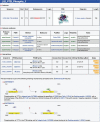The eukaryotic linear motif resource ELM: 10 years and counting
- PMID: 24214962
- PMCID: PMC3964949
- DOI: 10.1093/nar/gkt1047
The eukaryotic linear motif resource ELM: 10 years and counting
Abstract
The eukaryotic linear motif (ELM http://elm.eu.org) resource is a hub for collecting, classifying and curating information about short linear motifs (SLiMs). For >10 years, this resource has provided the scientific community with a freely accessible guide to the biology and function of linear motifs. The current version of ELM contains ∼200 different motif classes with over 2400 experimentally validated instances manually curated from >2000 scientific publications. Furthermore, detailed information about motif-mediated interactions has been annotated and made available in standard exchange formats. Where appropriate, links are provided to resources such as switches.elm.eu.org and KEGG pathways.
Figures



References
-
- Tompa P. Intrinsically disordered proteins: a 10-year recap. Trends Biochem. Sci. 2012;37:509–516. - PubMed
-
- Dunker AK, Lawson JD, Brown CJ, Williams RM, Romero P, Oh JS, Oldfield CJ, Campen AM, Ratliff CM, Hipps KW, et al. Intrinsically disordered protein. J. Mol. Graph. Model. 2001;19:26–59. - PubMed
-
- Uversky VN, Gillespie JR, Fink AL. Why are “natively unfolded” proteins unstructured under physiologic conditions? Proteins. 2000;41:415–427. - PubMed
-
- Wright PE, Dyson HJ. Intrinsically unstructured proteins: re-assessing the protein structure-function paradigm. J. Mol. Biol. 1999;293:321–331. - PubMed
-
- Fuxreiter M, Tompa P, Simon I. Local structural disorder imparts plasticity on linear motifs. Bioinformatics. 2007;23:950–956. - PubMed
Publication types
MeSH terms
Substances
Grants and funding
LinkOut - more resources
Full Text Sources
Other Literature Sources

